Related Research Articles

Heavy metal fashion is the style of dress, body modification, make-up, hairstyle, and so on, taken on by fans of heavy metal, or, as they are often called, metalheads or headbangers. While the style has changed from the 1970s to the 2020s, certain key elements have remained constant, such as black clothes, long hair and leather jackets. In the 1980s, some bands began wearing spandex. Other attire includes denim or leather vests or jackets with band patches and logos, t-shirts with band names, and spiked wristbands. It can also include with heavier subgenres of metal: bullet belts, gas masks, and war gear.

Leonor Fini was an Argentine-Italian surrealist painter, designer, illustrator, and author, known for her depictions of powerful and erotic women.

Empire silhouette, Empire line, Empire waist or just Empire is a style in clothing in which the dress has a fitted bodice ending just below the bust, giving a high-waisted appearance, and a gathered skirt which is long and loosely fitting but skims the body rather than being supported by voluminous petticoats. The outline is especially flattering to apple shapes wishing to disguise the stomach area or emphasize the bust. The shape of the dress also helps to lengthen the body's appearance.

Hussein Chalayan, is a British-Cypriot fashion designer. He has won the British Designer of the Year twice, and he was awarded the MBE in 2006.

Viktor & Rolf is a Dutch avant-garde luxury fashion house founded in 1993 by Viktor Horsting and Rolf Snoeren. For more than twenty years, Viktor & Rolf have sought to challenge preconceptions of fashion and bridge the divide between fashion and art. Viktor & Rolf have designed both haute couture and ready-to-wear collections. The duo is renowned for their avant-garde designs, which rely heavily on theatrical and performative fashion runways.

Nuit Blanche is an annual all-night or night-time arts festival of a city. A Nuit Blanche typically has museums, private and public art galleries, and other cultural institutions open and free of charge, with the centre of the city itself being turned into a de facto art gallery, providing space for art installations, performances, themed social gatherings, and other activities.
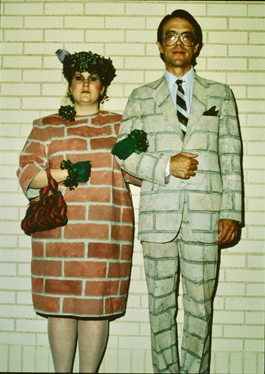
Adelle Lutz is an American artist, designer and actress, most known for work using unconventional materials and strategies to explore clothing as a communicative medium. She first gained attention for the surreal "Urban Camouflage" costumes featured in David Byrne's film True Stories (1986).

Henry Bond, FHEA is an English writer, photographer, and visual artist. In his Lacan at the Scene (2009), Bond made contributions to theoretical psychoanalysis and forensics.
Gary Simmons is an American artist from New York City. Using icons and stereotypes of American popular culture, he creates works that address personal and collective experiences of race and class. He is best known for his "erasure drawings," in which he draws in white chalk on slate-painted panels or walls, then smudges them with his hands – a technique that renders their imagery ghostly.
Wadsworth Aikens Jarrell is an American painter, sculptor and printmaker. He was born in Albany, Georgia, and moved to Chicago, Illinois, where he attended the Art Institute of Chicago. After graduation, he became heavily involved in the local art scene and through his early work he explored the working life of African-Americans in Chicago and found influence in the sights and sounds of jazz music. In the late 1960s he opened WJ Studio and Gallery, where he, along with his wife, Jae, hosted regional artists and musicians.
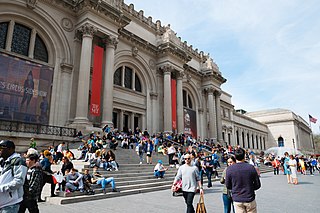
The Met Gala, formally called the Costume Institute Benefit, is the annual haute couture fundraising festival held for the benefit of the Metropolitan Museum of Art's Costume Institute in Manhattan. The Met Gala is popularly regarded as the world's most prestigious and glamorous fashion event. Fashion stars and models are able to express themselves by their fit according to the theme and social gathering. The event is known as "fashion's biggest night"; an invitation is highly sought after. Personalities who are perceived to be culturally relevant to contemporary society amongst various professional spheres, including fashion, film, television, music, theater, business, sports, social media and politics, are invited to attend the Met Gala, organized by the fashion magazine Vogue. The entry price for one ticket has risen to US$75,000 in 2024, an increase from $50,000 in 2023, to attend the annual gala in the world's principal financial center and fashion capital, New York City.
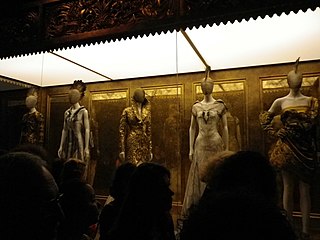
The Anna Wintour Costume Center is a wing of the Metropolitan Museum of Art main building in Manhattan that houses the collection of the Costume Institute, a curatorial department of the museum focused on fashion and costume design. The center is named after Anna Wintour, the longtime editor-in-chief of Vogue, Chief Content Officer of Condé Nast, and chair of the museum's annual Met Gala since 1995. It was endowed by Lizzie and Jonathan Tisch. As of August 2017, the chief curator is Andrew Bolton.
Inspection Medical Hermeneutics was a pioneering artists’ collective formed in December 1987 in a squat in Furman Lane in Moscow.

The Chapeau à la Paméla, Pamela hat or Pamela bonnet described a type of straw hat or bonnet popular during the 1790s and into the first three quarters of the 19th century. It was named after the heroine of Samuel Richardson's 1741 novel Pamela; or, Virtue Rewarded. While Pamela hats and bonnets underwent a variety of changes in shape and form, they were always made from straw. The mid-19th-century version of the Pamela hat was a smaller version of an early 19th-century wide-brimmed style called the gipsy hat.

Jean-François Bony was a French painter, draftsman, embroiderer, silk manufacturer, and flower painter. A talented artist, his designs include studies of a dress and mantle proposed for the wearing of Josephine de Beauharnais at the coronation of Napoleon. Bony was active before, during and after the French Revolution, also designing fabrics for Marie Antoinette, Empress Marie Louise and Napoleon himself.

Ellen Driscoll is a New York-based American artist, whose practice encompasses sculpture, drawing, installation and public art. She is known for complex, interconnected works that explore social and geopolitical issues and events involving power, agency, transition and ecological imbalance through an inventive combination of materials, technologies, research and narrative. Her artwork often presents the familiar from unexpected points of view—bridging different eras and cultures or connecting personal, intimate acts to global consequences—through visual strategies involving light and shadow, silhouette, shifts in scale, metaphor and synecdoche. In 2000, Sculpture critic Patricia C. Phillips wrote that Driscoll's installations were informed by "an abiding fascination with the lives and stories of people whose voices and visions have been suspended, thwarted, undermined, or regulated." Discussing later work, Jennifer McGregor wrote, "Whether working in ghostly white plastic, mosaic, or walnut and sumi inks, [Driscoll's] projects fluidly map place and time while mining historical, environmental, and cultural themes."

Camp: Notes on Fashion was the 2019 high fashion art exhibition of the Anna Wintour Costume Center, a wing of the Metropolitan Museum of Art in New York that houses the collection of the Costume Institute.
AngloMania: Tradition and Transgression in British Fashion was an exhibition curated by Andrew Bolton at the Metropolitan Museum of Art that ran from May 3 to September 4, 2006. The exhibition featured fashion from throughout Europe in the eighteenth-century that was influenced directly by British attitudes, ideas, and trends. However, these were not accurate depictions of British fashion, but idealized depictions of "a nation's notorious vanity, a romance with itself, and the eccentric desire of English designers to re-establish the establishment." The exhibit is composed of nine "theatrical installations containing clothed mannequins and paintings" that contrasted historical and modern aspects of fashion.
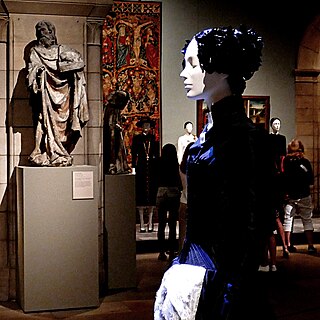
Heavenly Bodies: Fashion and the Catholic Imagination was the 2018 high fashion art exhibition of the Anna Wintour Costume Center, a wing of The Metropolitan Museum of Art (MMA) which houses the collection of the Costume Institute.
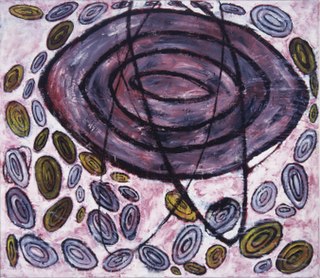
Joan Moment is an American painter based in Northern California. She emerged from the 1960s Northern California Funk art movement and gained attention when the Whitney Museum of American Art Curator Marcia Tucker selected her for the 1973 Biennial and for a solo exhibition at the Whitney in 1974. Moment is known for process-oriented paintings that employ non-traditional materials and techniques evoking vital energies conveyed through archetypal iconography. Though briefly aligned with Funk—which was often defined by ribald humor and irreverence toward art-world pretensions—her work diverged by the mid-1970s, fusing abstraction and figuration in paintings that writers compared to prehistoric and tribal art. Critic Victoria Dalkey wrote that Moment's methods combined chance and improvisation to address "forces embodied in a universe too large for us to comprehend, as well as the ... fragility and transience of the material world."
References
- 1 2 3 "Katell le Bourhis by Elizabeth Cannon – BOMB Magazine". bombmagazine.org. March 7, 1993. Retrieved September 26, 2020.
- 1 2 3 4 5 Costume Institute (New York, N.Y.), ed. (1992). Fashion and history: [installation photographs, wall text] a dialogue, December 7, 1992 – March 21, 1993.
- ↑ Tobi Tobias (March 7, 1993). "Design for living". washingtonpost.com. Retrieved September 26, 2020.
https://fashionexhibitionmaking.arts.ac.uk/fashion-and-history-a-dialogue/